
Chapter 9: Current and Resistance
Up to this point, in our consideration of electric charges in non-conductors and conductors, we've restricted ourselves to static situations: charges aren't moving, or they move only briefly as they arrange themselves into an equilibrium position.
9.0. Overview
More interesting than this, however, is the subject or current, in which charges in a conductor are induced to move by placing an electric potential over them. These next two chapters are going to explore some of the different ways we can understand and analyze electric current.
Let's get started!
9.1. Electric Current
Current simply refers to the continual movement of charge through an electric conductor.
Definition: Electric current
Current is the time-rate at which charge flows through a conductor.
Why would charges be moving in a conductor? We know that charges experience a force when subjected to an electric field, F = qE. By inserting a potential source of potential difference into a conducting loop, we set up an electric field in the conductor that causes charges to move through the loop. As long as the potential difference is maintained, the charges will move.
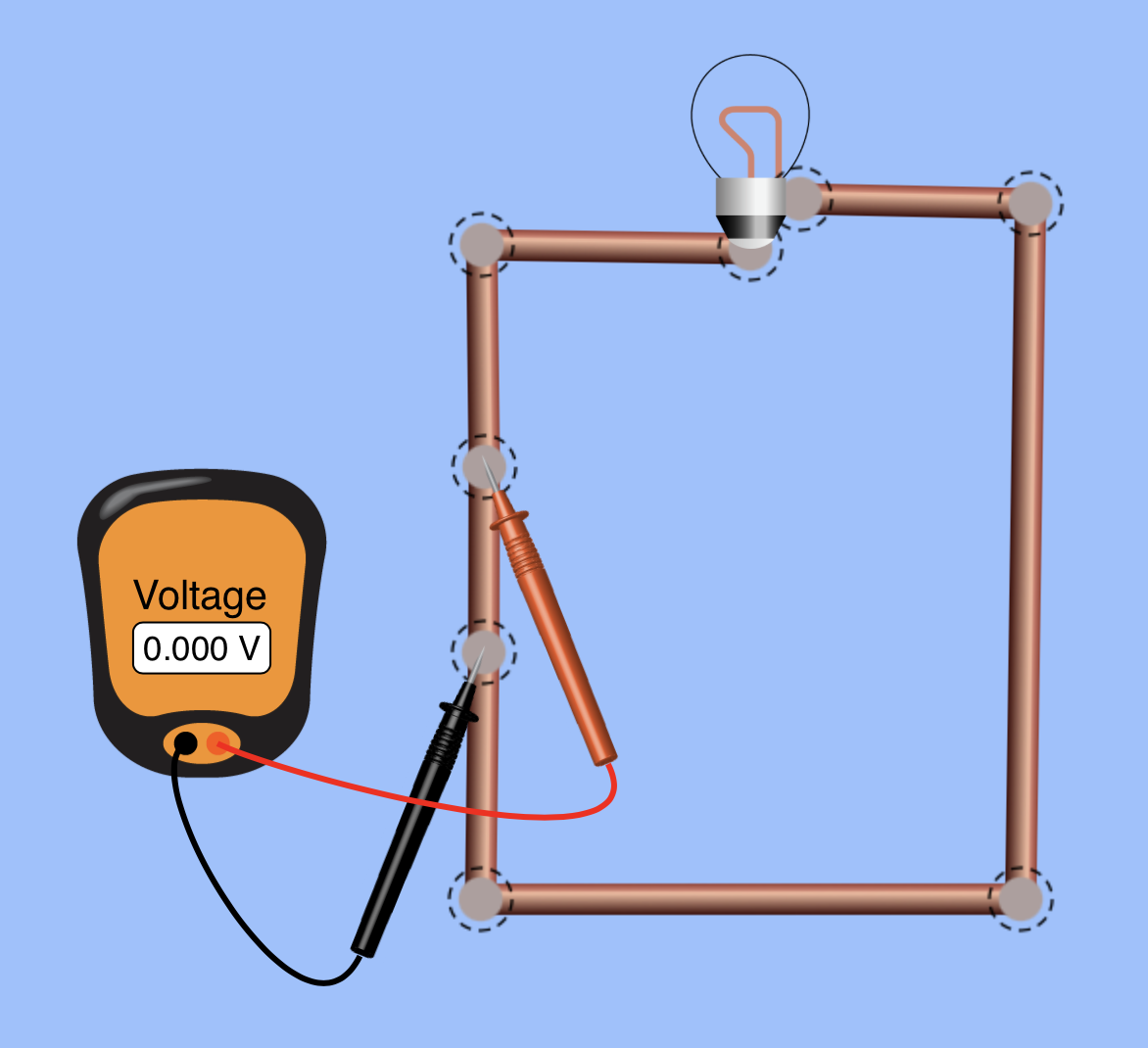
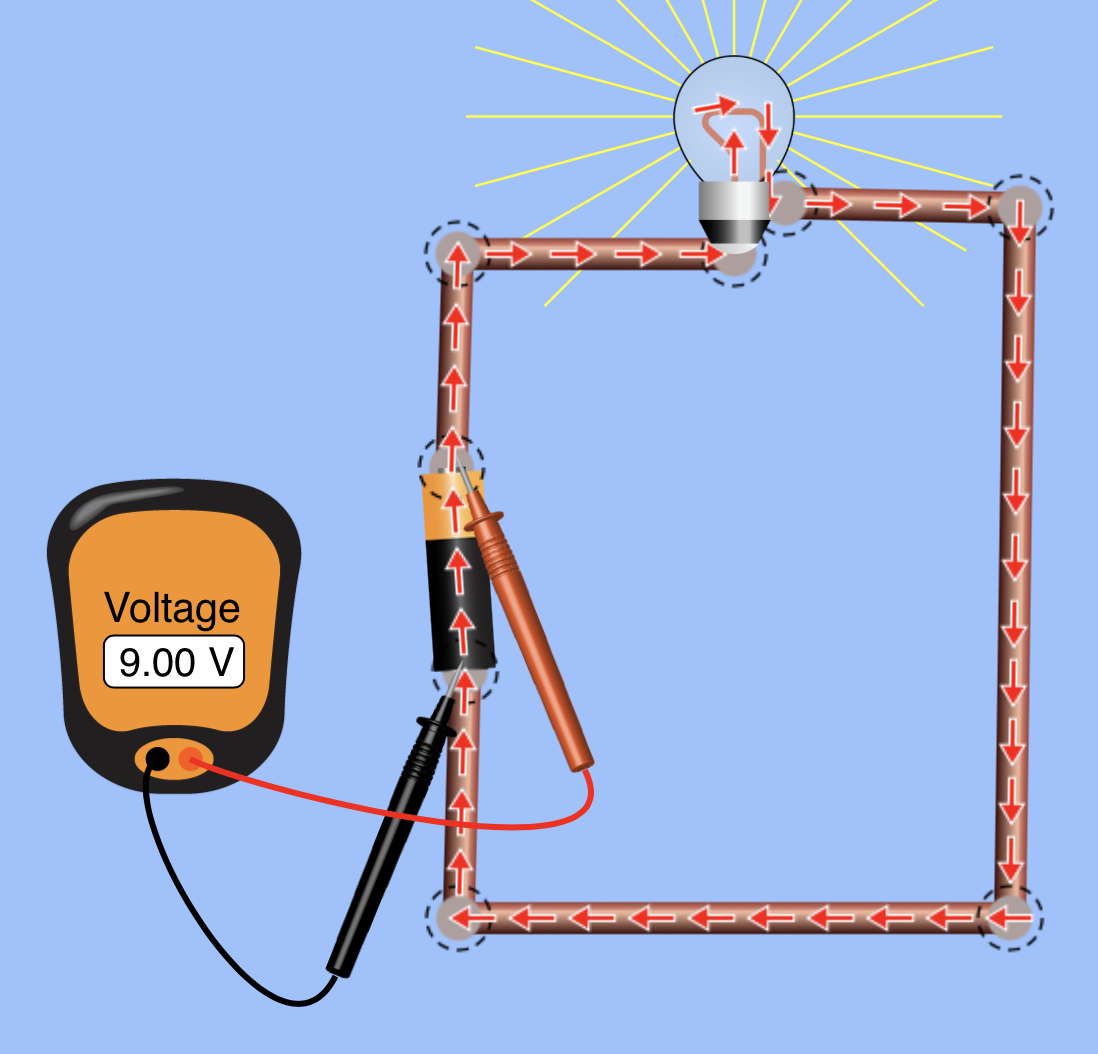
How many electrons?
A current of 200 milliAmps flows through a wire. How many electrons pass a given point in the wire every second?
A lot of them.
9.2. Resistance
Free electrons in a conductor have the ability to move from one atom to another, and it is this movement of charges that makes up a current. The free electrons that make their way through a conductor actually move rather slowly, inhibited by collisions with atoms and other electrons: their net movement through the conductor is called drift velocity.
We don't need to wait for a given electron to emerge from a battery to make its way all the way around a current loop, however. The electric field that is produced by the potential difference is transmitted through the conducting loop at near light-speed, causing charge to flow throughout the circuit nearly simultaneously. By way of analogy, if you have a garden hose filled with water, and you turn on the faucet at one end, you don't need to wait for the water just leaving the faucet to make its way through the hose—the water pressure travels through the body of water much more quickly than the actual water molecules do, and water comes out of the end of the hose relatively quickly.
We have several ways of describing how hard it is for electrons to move through a conductor.
9.2.1. Resistance and Resistivity
As the electric field pushes through the wire, there is a resistance R to the flow of charge. Let's see how we can describe that resistance.
Definition: Resistivity
The resistivity of a material is determined experimentally, and varies depending on the material: copper has a very low resistivity, meaning electrons flow throw it relatively easily, while carbon has a higher resistivity—charges can flow through, but it's harder for them to travel.
This leads us to a more useful measurement: resistance.
Definition: Resistance
The quantity resistance is based on the length of the wire L, the cross-sectional area A of the conductor, and the material's resistivity p to the current.
As you think about resistance, it may help to consider it in terms of a classic physical pedagogical tool, "the Water Analogy."
A pipe carries water through at a given rate that depends on a number of factors. A shorter pipe allows water to flow more quickly than a longer pipe—the water interacts with the walls of the pipe, which slow it down some. A wider pipe allows water to flow more quickly than a narrow pipe—the greater cross-sectional area allows for more water to fit into the pipe. And any foreign matter in the pipe—larger stones with lots of dead space for the water to move through, versus pebbles which block more of the pipe, or even sand which does a better job of clogging the pipe—is analogous to the resistivity of the conductor.
In the Water Analogy the pipes allow water to circulate in a closed system, and the pressure from the pump drives water throughout the entire system. Note that the flow of current is the same everywhere throughout the system: the pump can't push out more water than it has coming into it. So a flow of 2 liters per minute coming out of the pump is also a measure of the flow going into the clogged section of the pipe, which is the same as the flow rate of water coming out of the clog, and on into the pump again.
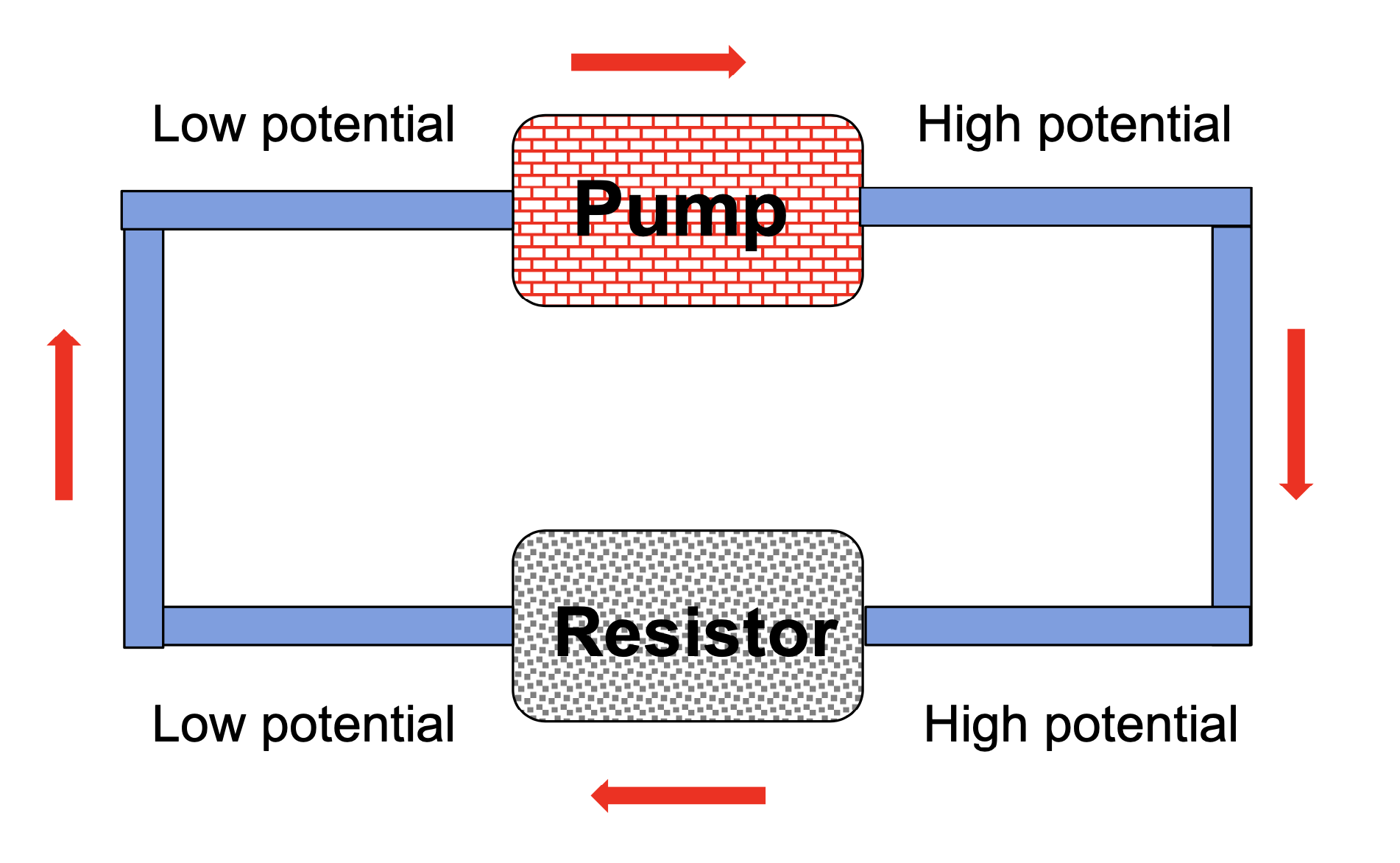
What happens if the clogged part of the pipe is cleared? More water will flow. What happens if the pump pressure is reduced? Less water will flow.
These quantities—pressure, water flow, and clog resistance—are directly analogous to electric potential, electric current, and resistance in a closed circuit.
9.3. Ohm's Law
The German scientist Georg Ohm (1789-1854) experimented with Alessandro Volta's "voltaic piles" and quickly discovered the law which now bears his name.
Ohm's Law
As the potential in a circuit increases, so does the amount of current going through the circuit, in direct proportion.
By graphing potential V vs current I for a range of values, Ohm determined a constant relationship for a given length of wire (with a fixed resistance):
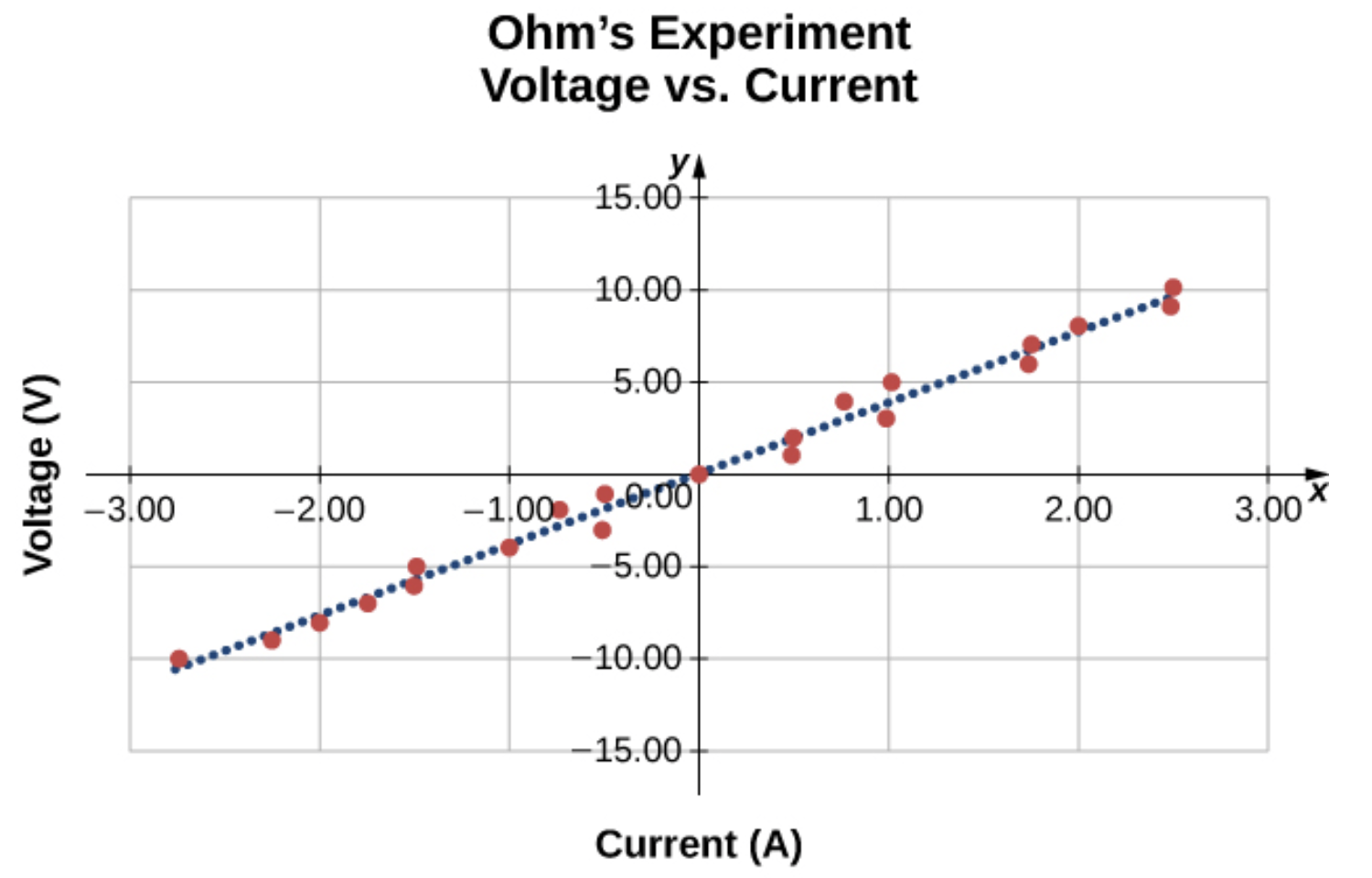
Not all conductors exhibit this behavior, but the ones that do are called ohmic, and that's what we'll be covering in this course. Non-ohmic conductors are not part of our curriculum.
Ohm's Law, then, summarizes the relationship between potential V, current I, and resistance R.
The unit of resistance is the "Ohm", indicated by a Greek capital omega: Ω
These three animations demonstrate the relationship. Given any two values in the animations, it's simple to calculate the value of the third using Ohm's Law.
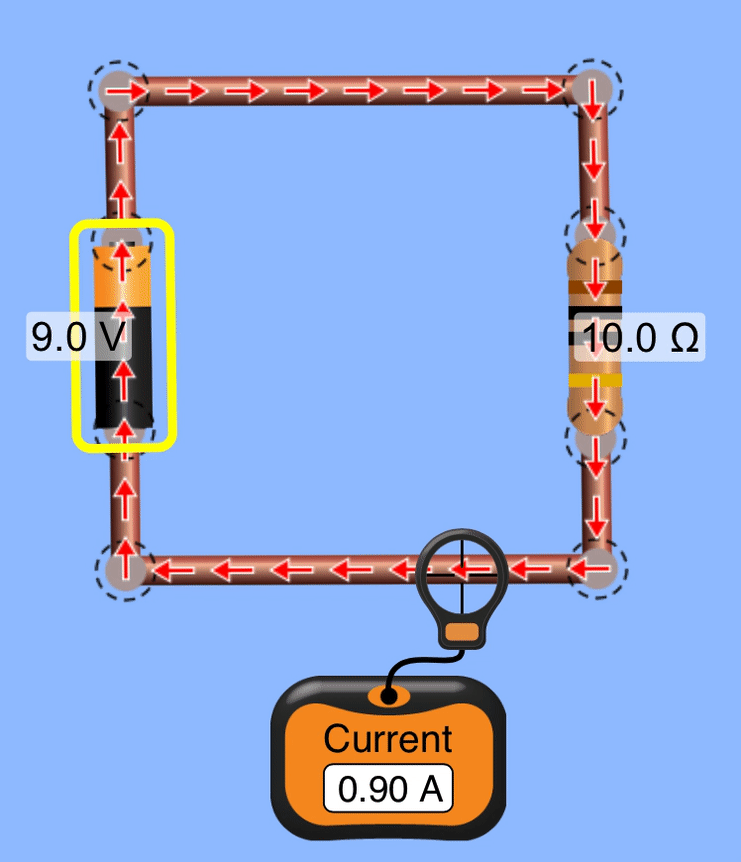
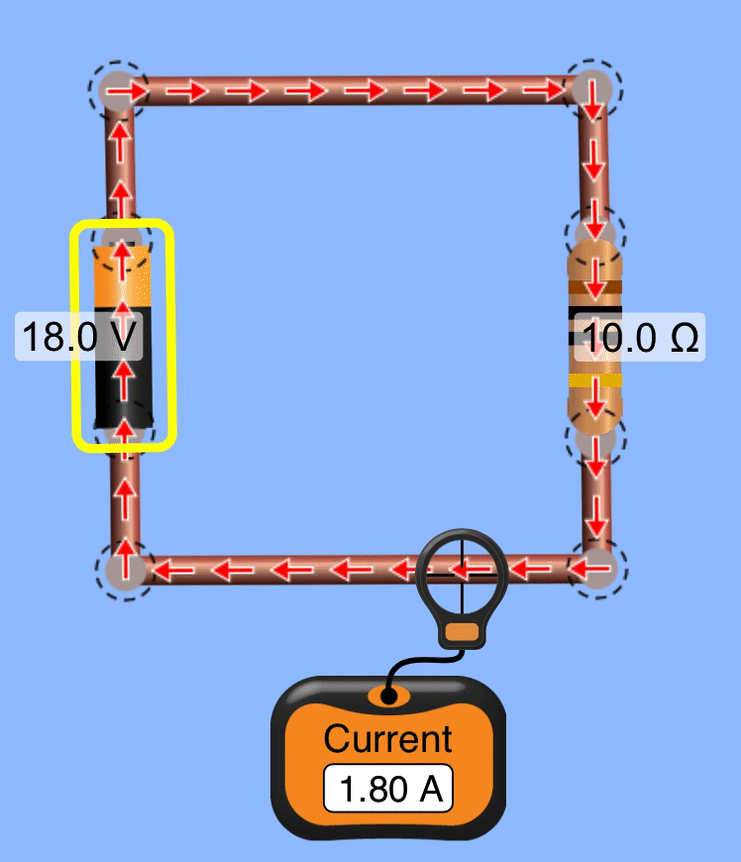
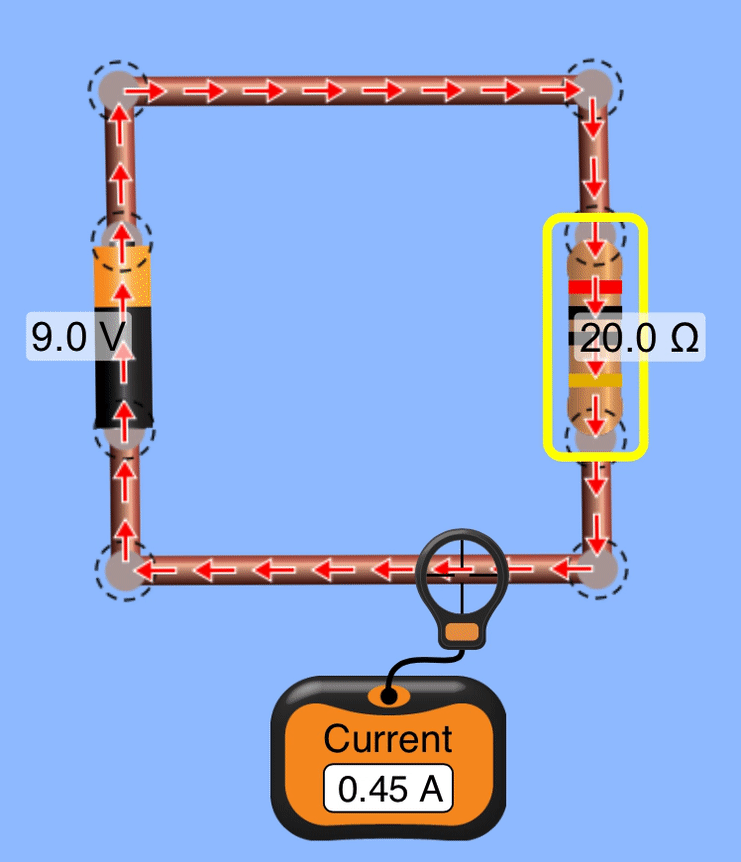
Video Projector
A classroom video projector requires a 85 Vrms voltage to operate, and "draws" 2.7 Amps of current.
- What is the resistance of the video projector?
- If the projector were instead connected to a 12 V potential difference provided by a car battery, how much current would be running through the projector? Would it be sufficient to operate the projector?
- 44.4 Ω
- With one tenth of the potential, the projector will have 1/10 the current running through it, or 0.27 Amps. This is probably insufficient to operate the projector.
What does an actual "simple circuit" look like? How does one perform measurements on that circuit? Let's take a look.
9.3.1. The "secret" Resistor Code
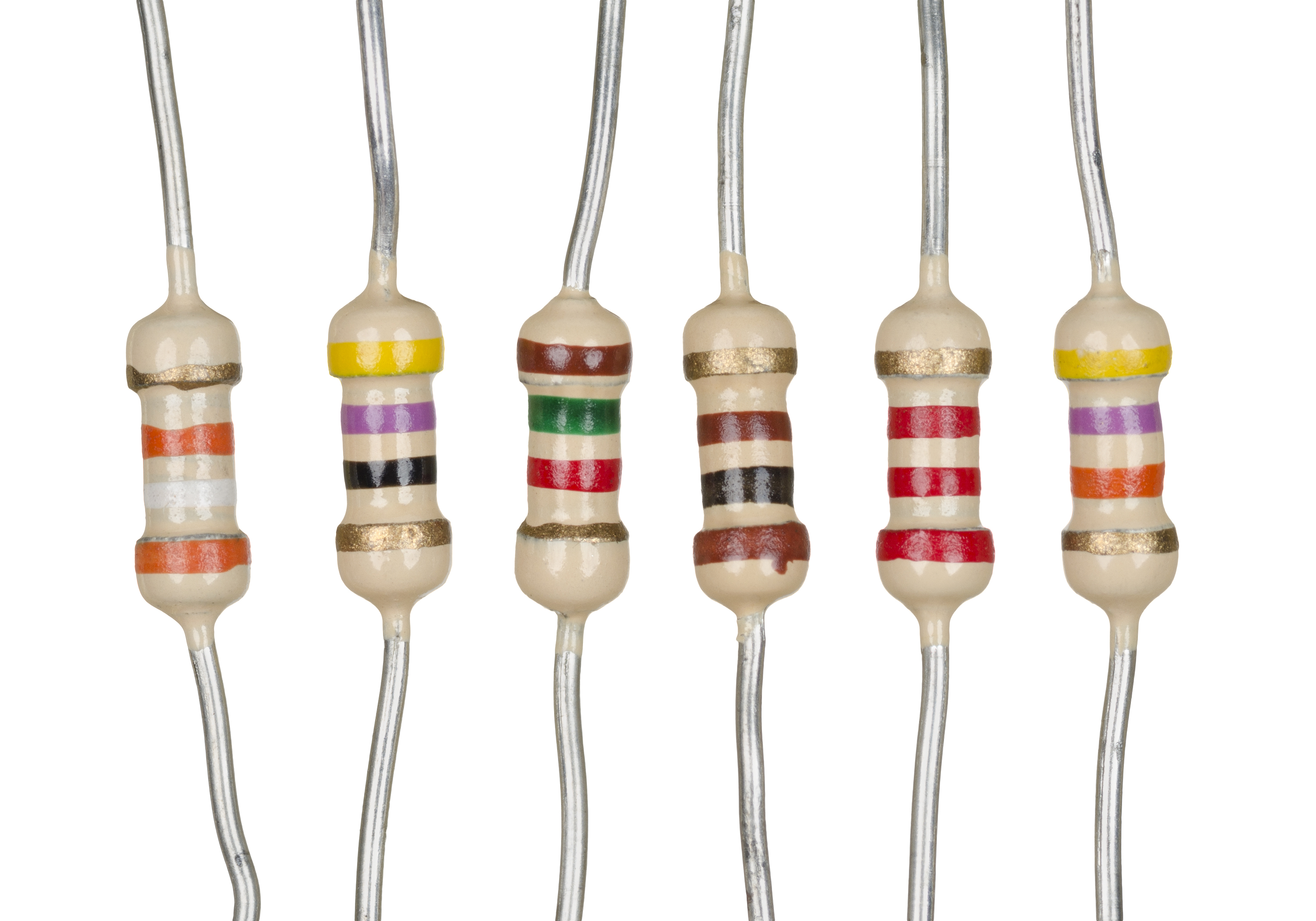
Resistors are an important component of electronic circuits, and one of the most colorful—to indicate their values, most resistor have a series of colored bands painted on them, which can be interpreted according to a resistor code [Wikipedia]. A simplified version of that code is given here.
In the typical 4-band code, the four bands represent four different parts of the value:
- First band - the first digit of the resistance
- Second band - the second digit of the resistance
- Third band - the multiplier (a power of 10)
- Fourth band - the tolerance of the resistor, ie. how close its stated value is to its actual value
So, let's consider the resistor on the right side of the image above, which has bands colored yellow-violet-orange-gold. These would indicate that this component has a resistance of (consulting the table below) 4 7 × 103 = 47000 Ω = 47 kΩ, +/- 5%.
| Color | Number | Multiplier | Tolerance |
| Black | 0 | 10^0 | |
| Brown | 1 | 10^1 | |
| Red | 2 | 10^2 | +/- 2% |
| Orange | 3 | 10^3 | |
| Yellow | 4 | 10^4 | |
| Green | 5 | 10^5 | |
| Blue | 6 | 10^6 | |
| Violet | 7 | 10^7 | |
| Gray | 8 | 10^8 | |
| White | 9 | 10^9 | |
| Gold | 10^-1 | +/- 5% | |
| Silver | 10^-2 | +/- 10% | |
| No color | +/- 20% |
Finding the right resistor
You have an LED with essentially no resistance, that takes 300 mA of current to light.You have a 9.00 Volt battery that you’d like to use to light the LED.
- What will your circuit look like?
- How large a resistor should you use to make sure that the LED doesn't blow out?
- What color code should you look for on your resistor?
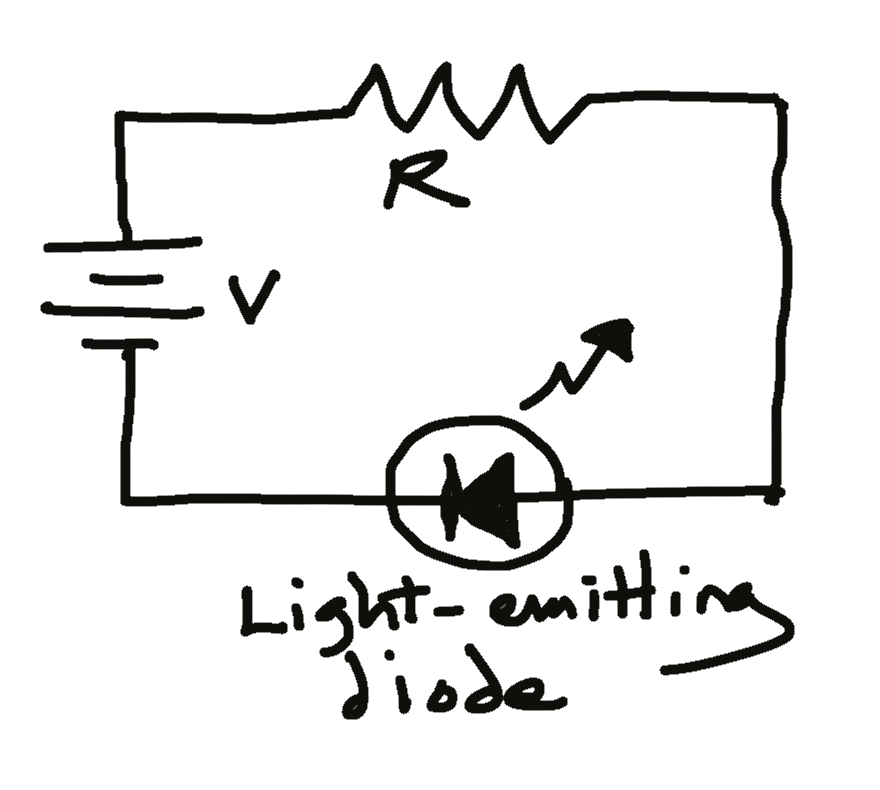
- Using the given current and voltage, we need to calculate the resistance.
- 30 Ω = 30 × 100, so that would be 3, 0, 0, and the tolerance at the end. 3, 0, 0, translates to orange, black, black. If you circuit is a sensitive one that benefits from having a higher precision resistor, you'll want a gold (+/- 5%) or even a red (+/- 2%) tolerance. If the circuit you're building is a little less critical a silver (+/- 10%) or even a no band (+/- 20%) tolerance will be fine.
9.3.2. Enthusiasts
Some people really get into the resistor code.
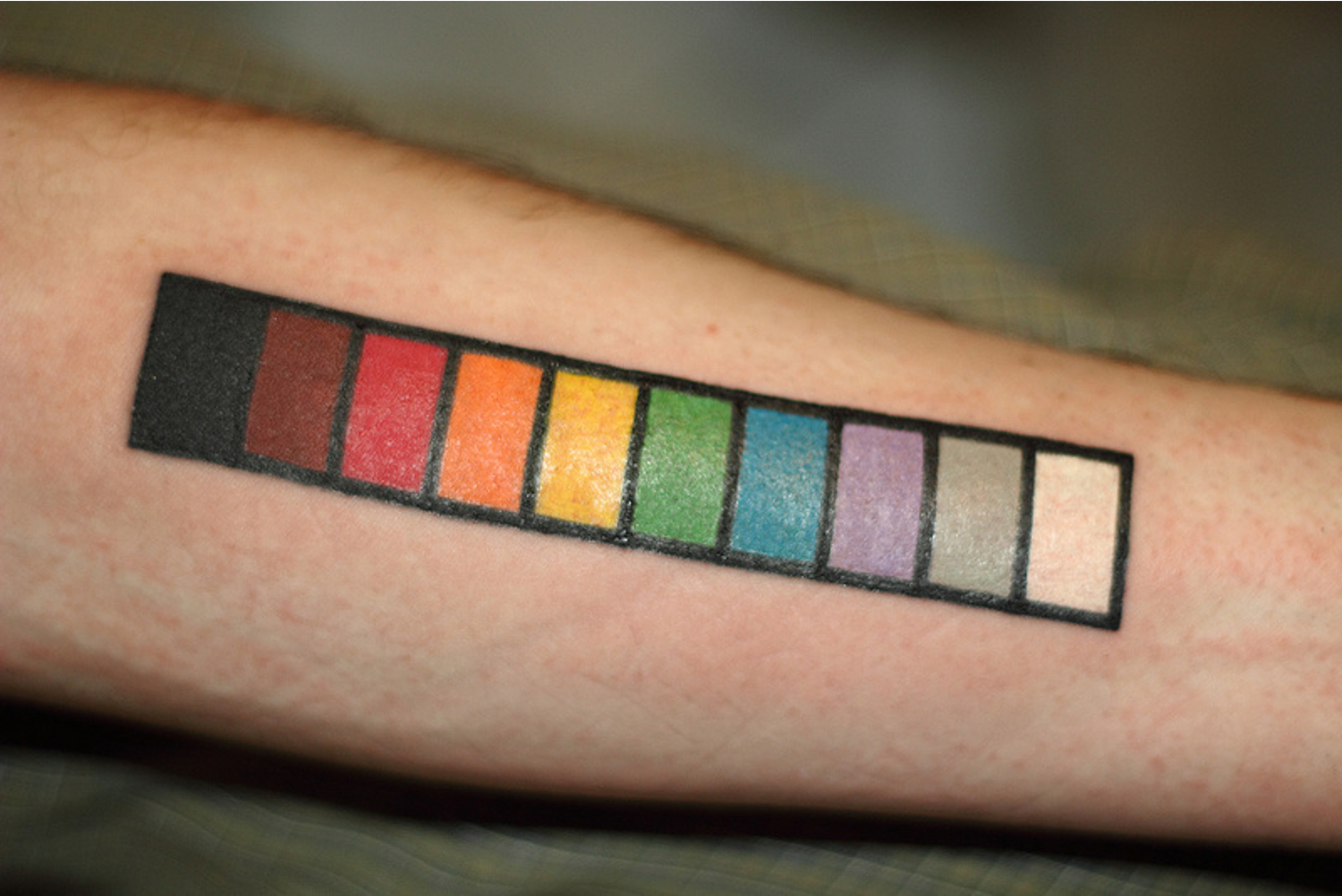
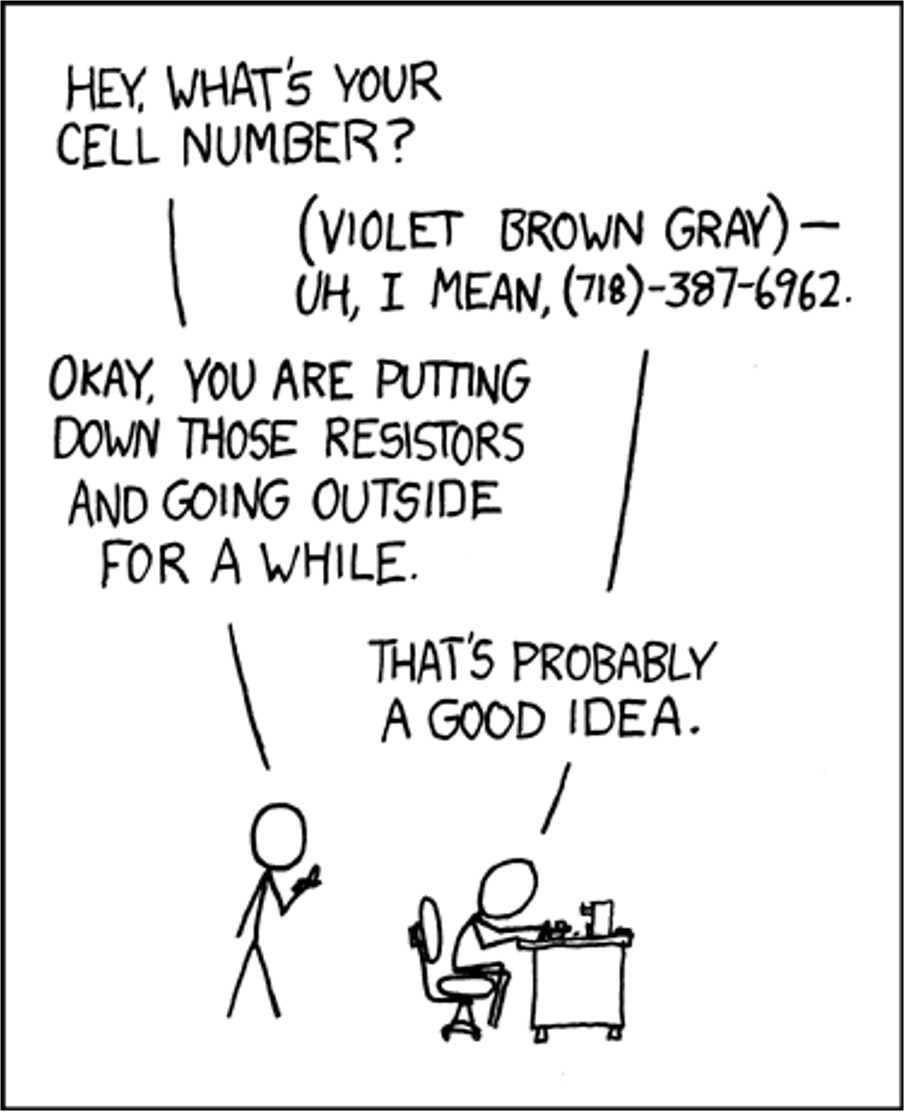

9.4. Electric Energy and Power
We've already looked at it take energy to deposit charges onto the plates of a capacitor. For any given charge, the amount of energy it takes to push the charge onto the plate of the capacitor is dU = dqΔV.
Let's take the time derivative of that expression:
This reveals that the Power produced by a battery—the Joules per second that it delivers to a circuit—can be easily calculated.
The same formula can be used to determine how much power is dissipated when the potential decreases as current flows through a resistance.
We can use Ohm's Law to solve for other variations on the "power dissipated by a resistance" question:
Calculating Power
A lightbulb is rated at 120V, 75W, and the bulb is powered by a 120V AC power supply.
- Calculate how much current is going through the bulb.
- Calculate the resistance of the bulb.
- A 75-Watt bulb is very bright, dissipating a lot of radiant energy. How many Joules of energy does it dissipate if it's left on for an hour?
- If this bulb was instead connected to a 12-Volt car battery, how much power would it use?
- Use the potential decrease over the resistor and the current running through it:
- With reduced Voltage, the amount of current won't be the same, so we can't use P = IV to solve this problem. The resistance is (approximately) the same, so let's try that:
With this reduced amount of power being used by the lightbuilt, it is doubtful that any significant amount of light is being produced.
Energy is expensive
An electric heater draws 15 Amps on a 120 Volt line. It operates 3 hours/day, for 30 days/month. Pacific Gas & Electric charges 8¢ per kWh.
- How much Power does the heater draw?
- How much does it cost to run the heater for a month?